Chapter 1: Introduction

Blackdown Hills National Landscape Management Plan 2025-2030
Chapter 1: Introduction
In this chapter:
1.1 Purpose and role of the management plan
1.2 Guiding principles for partnership and management
1.4 Summary of forces for change: key issues, challenges and opportunities
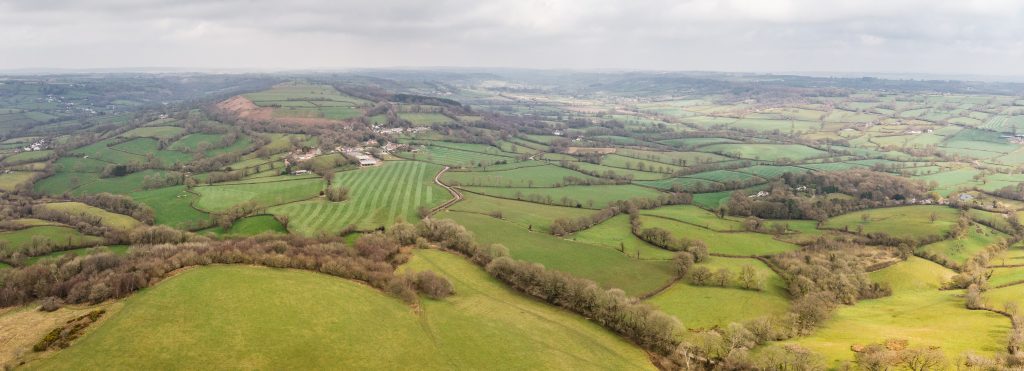
1.1 Purpose and role of the Management Plan
Context
Areas of Outstanding Natural Beauty (AONBs) are nationally important protected landscapes, known as National Landscapes since 2023. The 46 National Landscapes in England, Wales and Northern Ireland cover just under 20% of the UK. Their distinctive character and natural beauty make them some of the most special and cherished places in which to live and to visit.
Together with National Parks, National Landscapes represent our most outstanding landscapes; unique and irreplaceable national assets, each with such distinctive character and natural beauty that they are recognised internationally as a Category V Protected Landscape by the International Union for the Conservation of Nature (IUCN), part of the global Protected Areas family to be managed in the interest of everyone – local residents, businesses, visitors, and the wider public – and protected for future generations.
The Blackdown Hills National Landscape is a distinctive, diverse rural landscape stretching from the prominent scarp above the M5 in the north to Honiton and Axminster in the south, and from Chard in the east to Culmstock in the west. Ranging from around 50 to 310 metres above sea level, the area is characterised by a sense of relative remoteness and tranquillity and was designated as an Area of Outstanding Natural Beauty in 1991.
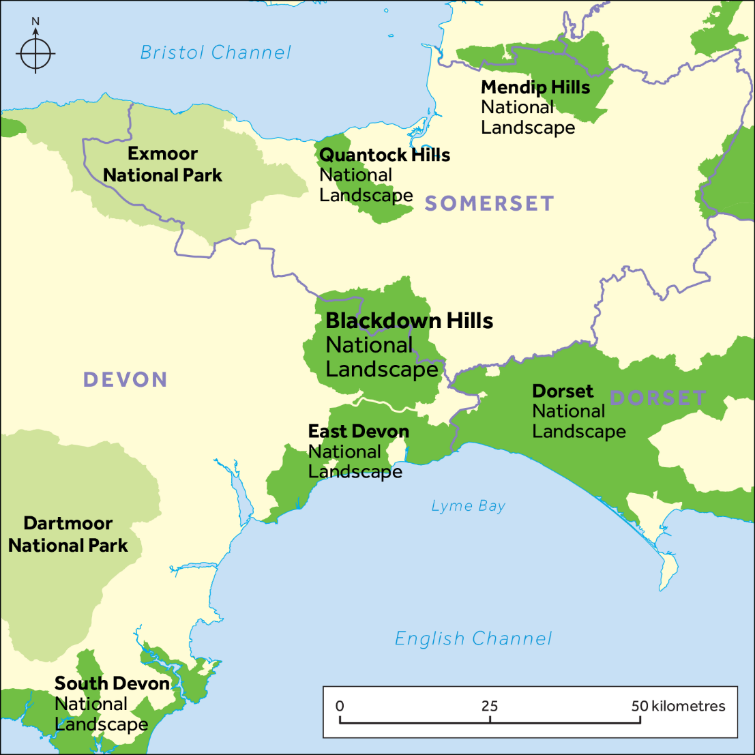
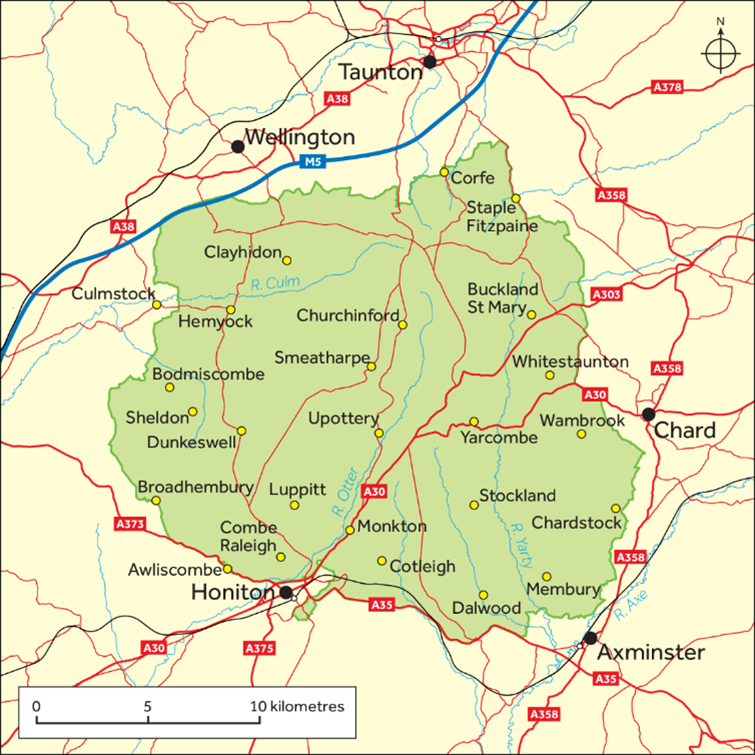
To the south, between Honiton and Axminster, the Blackdown Hills National Landscape shares a boundary with the East Devon National Landscape, and not far to the east is Dorset National Landscape. Looking northward, there is a strong visual relationship across the Vale of Taunton with the Quantock Hills National Landscape and Exmoor National Park. A population of around 150,000 live in the nearby towns.
What is the Management Plan for?
The Management Plan blends national and local priorities and seeks to address them in a way that is right for the Blackdown Hills – the landscape, environment, and communities – to make sure the very special character of the area is conserved and enhanced for future generations.
The statutory Management Plan is the single most important policy document for the National Landscape. It sets out the ambition, strategy, and guidance for the conservation and enhancement of the Blackdown Hills National Landscape for the next five years. It is a revised and updated version of the previous Management Plan 2019-2024.
Its purpose is to:
- Highlight the special qualities and significance of the National Landscape.
- Present a vision for the future of the National Landscape and set the direction of travel
- Set out objectives and policies to secure the vision.
- Define the pace and scale of action required to achieve our vision.
- State the condition of the National Landscape and establish measures of success and targets upon which progress can be measured and evaluated.
Working together with others to achieve success underscores all National Landscape Partnership work. As the principal strategic guidance for the Blackdown Hills National Landscape, the plan, therefore, provides the basis to:
- Inform and influence decisions.
- Stimulate and prioritise action.
- Promote collaboration.
- Help coordinate and prioritise resources.
Who is the Management Plan for?
This Management Plan has been prepared by the Blackdown Hills National Landscape Partnership on behalf of the relevant local authorities. However, it is a plan for the geographic area of the National Landscape (and beyond), not a plan for the organisation. It provides a framework to help guide all activities affecting the conservation and enhancement of the National Landscape.




Everyone who has an active interest and role in the management of the Blackdown Hills National Landscape and in supporting the communities that live and work within it, has a role in implementing the Management Plan, through individual action as well as partnership working.
Its audiences include:
- Local authorities: The relevant authority organisations that are required to jointly prepare, adopt and review the Management Plan, and who carry out key functions, such as planning, that affect the National Landscape. The Management Plan, in its entirety, establishes the management policy of the responsible authorities.
- Blackdown Hills National Landscape Partnership organisations: These organisations will have a key role in delivering and championing the Management Plan and it provides a focus for their partnership and collaboration.
- Relevant authorities: All public bodies and statutory undertakers (including local authorities, government and governmental organisations, parish councils, utility providers, and the National Landscape Partnership) have a duty to seek to further the purpose of the National Landscape; this Management Plan will guide them in fulfilling their statutory duties.
- Landowners, land managers and developers: Those who own and manage land in the National Landscape have a vital role to play; the plan aims to guide, support and attract resources for sensitive management of the National Landscape.
- Local communities, businesses and visitors: Everyone who lives, works or visits the Blackdown Hills can play an active role in caring for the National Landscape; the plan identifies some of the priorities for action and ways to become involved.
- Others such as funding bodies, third sector, and voluntary groups and organisations may refer to the plan or use it to gain a greater understanding of the issues affecting the area.
This plan is ultimately about partnership working to make the vision a reality and identifying actions to encourage greater understanding, appreciation and enjoyment of the Blackdown Hills National Landscape. This will lead to sustained investment, prosperity for our rural communities, protection and enhancement of biodiversity and climate resilience.
1.2 Guiding principles for partnership and management
- The Management Plan will be used to direct strategic leadership in the delivery of meaningful benefits to the landscape, communities and economy of the Blackdown Hills National Landscape, while relevant authorities will seek to further the purpose of conserving and enhancing natural beauty in the conduct of their functions and decision making.
- Collaboration, coordination and partnership is to be encouraged amongst the wide range of national, regional and local agencies and organisations to secure appropriate funding and support for the care and enhancement of the Blackdown Hills.
- The Blackdown Hills National Landscape Partnership is the central vehicle to promote the roles and activities of all those involved in conserving and enhancing the Blackdown Hills National Landscape, and to showcase innovation and best practice.
- The Blackdown Hills National Landscape Partnership will monitor and report on the state of the National Landscape utilising tools such as the Protected Landscapes Targets and Outcomes Framework and local measures so that management interventions can be kept under review.
National Landscape Partnership Commendation
This Management Plan is endorsed by partnership organisations as the guiding framework for conserving and enhancing the special character of the Blackdown Hills National Landscape, while supporting and facilitating a thriving economy with vibrant communities.
1.3 Policy context
Although now known as a National Landscape, ‘Area of Outstanding Natural Beauty’ (AONB) remains the legal term for the designation and so is the terminology used in this section.
Legislation
Areas of Outstanding Natural Beauty (AONBs) are designated under the National Parks and Access to the Countryside Act 1949. The purposes of the AONB designation were updated and confirmed by the Countryside Commission in 1991:
“The primary purpose of the designation is to conserve and enhance natural beauty.
In pursuing the primary purpose, account should be taken of the needs of agriculture, forestry, other rural industries and the economic and social needs of local communities. Particular regard should be paid to promoting sustainable forms of social and economic development that in themselves conserve and enhance the environment.
Recreation is not an objective of designation, but the demand for recreation should be met so far as this is consistent with the conservation of natural beauty and the needs of agriculture, forestry and other uses.”
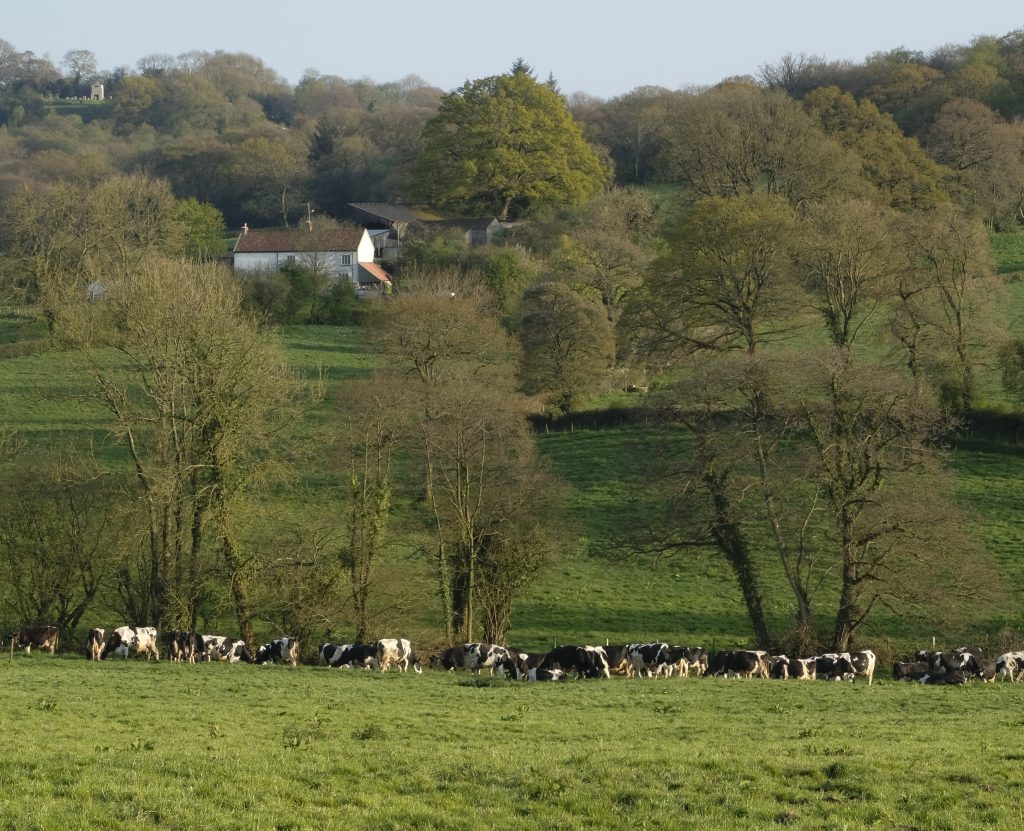
The Countryside and Rights of Way Act 2000 confirmed the significance of AONBs and created improved arrangements for their management. There are two key sections of the Act for AONBs:
- Section 85 placed a statutory duty on all ‘relevant authorities’ to have regard to the purpose of conserving and enhancing natural beauty when exercising or performing any function affecting land in AONBs.
- Section 89 placed a statutory duty on local authorities to prepare and review a Management Plan for each AONB in their administrative area.
The Levelling up and Regeneration Act 2023 (LURA) strengthens the duty on partners such as local authorities and public bodies (known as relevant authorities) in relation to conserving and enhancing Protected Landscapes. It amends the Countryside and Rights of Way Act 2000, placing a revised duty on relevant authorities:
“In exercising or performing any functions in relation to, or so as to affect, land in any [Protected Landscape] in England, a relevant authority must seek to further the specified purposes”.
This duty to “seek to further” replaces the existing duty to “have regard to” the specified purposes. The duty does not prevent relevant authorities from undertaking their statutory functions and discharging their legal duties and other responsibilities, but is intended to complement these requirements by ensuring that the purposes for which Protected Landscapes are designated for are recognised in reaching decisions and undertaking activities that impact these areas, and is considered to be an ‘active’ duty rather than a passive one.
Defra have produced guidance for relevant authorities on seeking to further the purposes of Protected Landscapes.
Amendments brought about by LURA also grant powers to the Secretary of State to make regulations to:
- Direct a relevant authority in the discharging of the duty.
- Require a protected landscape management plan to contribute to meeting any national environmental target set under the Environment Act 2021.
- Set out how a management plan must further the purposes of the designation.
- Require and set out how a relevant authority must contribute to the preparation, implementation and review of a management plan.
Defra and Natural England policy
Under the umbrella of the UK Government’s 25 Year Environment Plan (2018) the work and priorities of the National Landscape, as set out in the Management Plan, are required to contribute to Defra’s Environmental Improvement Plan (EIP23).
This sets the UK goals for enhancing the natural environment, including:
- The target to protect 30% of our land and sea for nature, through the Nature Recovery Network, by 2030 (the so-called ’30 by 30’ commitment which arises from the UK’s commitments at the COP15 Biodiversity summit).
- The target to restore or create more than 500,000 hectares of wildlife-rich habitats outside protected sites by 2042.
It also seeks to halt the decline in species abundance by the end of 2030, increasing it to above 2022 levels by 2042.

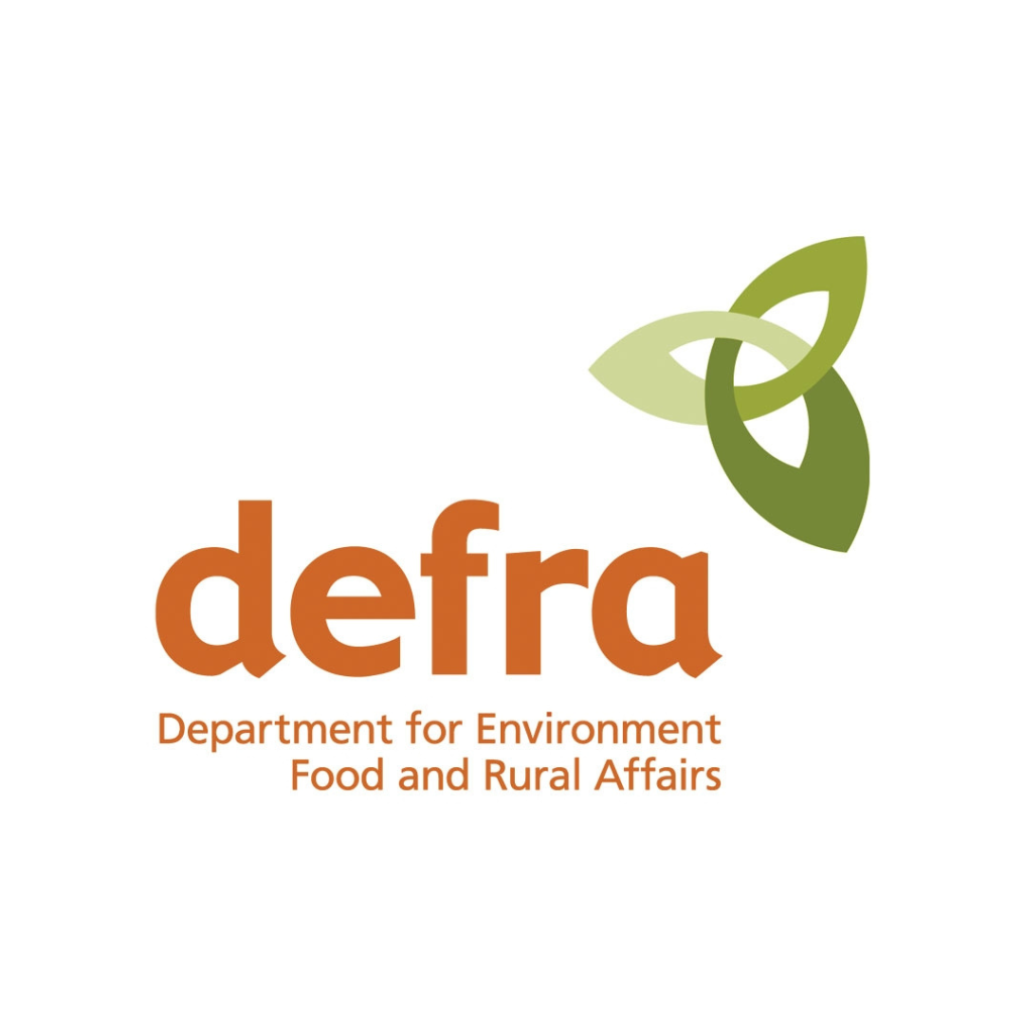
The ambition is to achieve high quality, accessible, natural spaces with increased biodiversity close to where people live and work, with a focus around the equal distribution of environmental benefits and resources to all.
Specifically, the Protected Landscapes Targets and Outcomes Framework sets the ambition for how Protected Landscapes are expected to achieve three outcomes from the Environmental Improvement Plan (EIP23) which relate to these goals:
- Goal 1: Thriving plants and wildlife.
- Goal 7: Mitigating and adapting to climate change.
- Goal 10: Enhancing beauty, heritage and engagement with the natural environment.
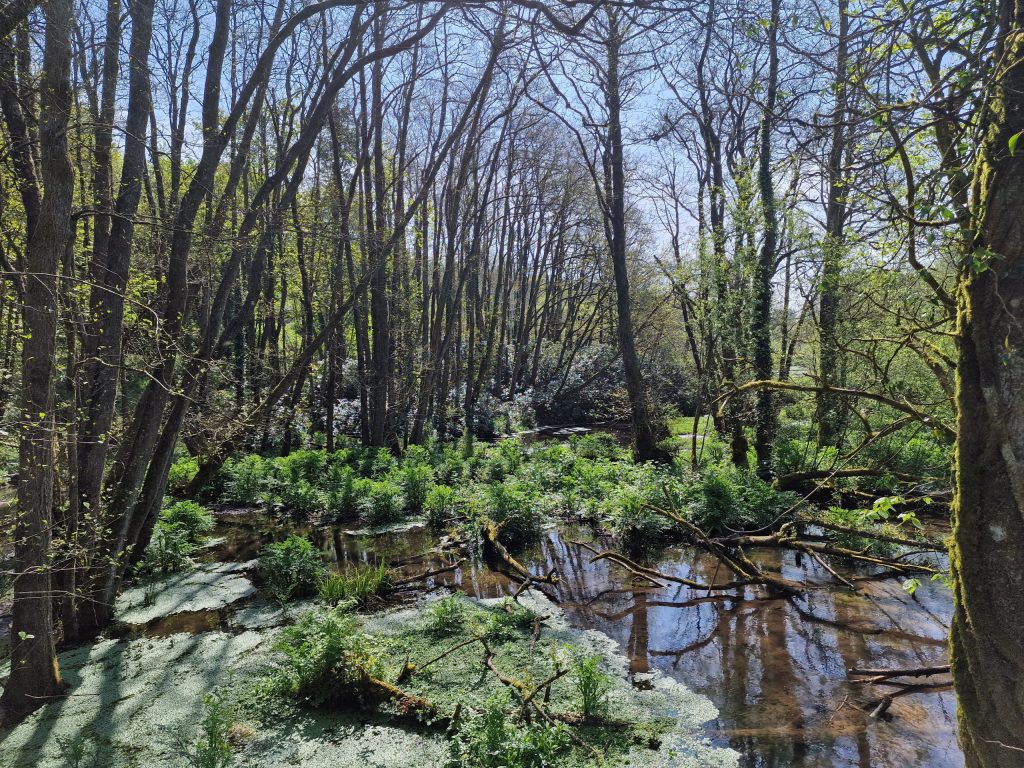
The Protected Landscape targets are non-statutory and create a shared ambition for all 44 of England’s Protected Landscapes. The targets are for the Protected Landscapes as places (the geographic area covered by the designation). These targets should be seen as a minimum contribution rather than a limit on a Protected Landscape’s ambition. Each individual Protected Landscape body, working with relevant local partners, will set their own individual contribution, which will be embedded in their management plan. Action will be coordinated by Protected Landscape bodies, and it will be the responsibility of all stakeholders, partners and land managers in the area to support their delivery.
Most of these changes follow recommendations made within the Landscapes Review 2019, an independent review of Designated Landscapes (National Parks and Areas of Outstanding Natural Beauty) in England, commissioned by the Government and led by Julian Glover.
“The Review aims not to diminish the character or independence of our designated landscapes, or to impose new burdens on them and the people who live and work in the areas they cover. Instead, its purpose is to ask what might be done better, what changes could assist them, and whether definitions and systems which, in many cases date back to their original creation, are still sufficient.”
The Landscapes Review produced 27 proposals across five themes of Landscapes Alive for Nature and Beauty, Landscapes for Everyone, Living in Landscapes, More Special Places and New Ways of Working. Some of the more strategic ones pertinent to management planning, include:
- Areas of Outstanding Natural Beauty (AONBs) strengthened with new purposes, powers and resources, renamed as National Landscapes.
- The state of nature and natural capital in our national landscapes should be regularly and robustly assessed, informing the priorities for action.
- Strengthened management plans should set clear priorities and actions for nature recovery including, but not limited to, wilder areas and the response to climate change, (notably tree planting and peatland restoration). Their implementation must be backed up by stronger status in law.
- A renewed mission to recover and enhance nature and a stronger mission to connect all people with our national landscapes.
Other key policy influences
International context
This management plan is both underpinned by and contributes towards delivery of the United Nations Sustainable Development Goals set out in the 2030 Agenda for Sustainable Development and which address social progress, economic well-being and environmental protection.
Local Nature Recovery Strategies
The Management Plan needs to account for Devon Local Nature Recovery Strategy and Somerset Local Nature Recovery Strategy, which are both currently under development.
As responsible authorities, Devon County Council and Somerset Council are preparing these Local Nature Recovery Strategies as part of a statutory duty, enshrined in the Environment Act 2021, to work with stakeholders across the public, private and voluntary sectors to agree priorities for natures recovery, map the most valuable existing areas for nature, and established shared proposals for action to be taken to recover nature.
Climate action planning
The Management Plan will be informed and influenced by Somerset’s Climate Emergency Strategy and the equivalent Devon Carbon Plan, plus the Climate Adaptation Strategy for Devon, Cornwall and the Isles of Scilly. In addition, partner local authorities have developed and updated climate strategies and action plans, including Mid Devon and East Devon
Local Plans
Planning policy and decisions that affect the conservation and enhancement of the natural beauty and character of the National Landscape are the responsibility of local authorities. This does not mean that there should be no development but that any development should complement the character of the landscape, be sustainable, and be of an appropriate scale and nature.
Any development proposal must be in accordance with the relevant local authority’s Development Plan, including core strategies, local plans, neighbourhood plans, and any supplementary planning documents adopted by the authority. This includes adopted local plans in the former Somerset districts of Somerset West and Taunton and South Somerset, East Devon District Council and Mid Devon District Council.
Agri-environment funding
A major vehicle for the delivery of actions advocated in the Management Plan, with respect to land management, is the suite of payment schemes which are either already available, or under development by Defra to replace the agri-environment schemes which used to be part of the UK’s farm support under the Common Agricultural Policy (CAP). Broadly falling under the heading of Environmental Land Management, the key payment schemes of relevance for the Blackdown Hills National Landscape are the Sustainable Farming Incentive, Countryside Stewardship, Farming in Protected Landscapes (operated by the National Landscape locally) and Landscape Recovery.
Integrating the management of the natural and historic environment
Other major players in supporting actions around conserving and enhancing natural beauty include Natural England, Historic England, and the National Lottery Heritage Fund. A recent Joint Statement between the three organisations mirrors the aims of this management plan and highlights;
‘We recognise that nature comprises habitats, species, geology, landscape, historic features, cultural connections, and the opportunities we have to connect with the environment. We acknowledge the complex interplay of these factors and the crucial role that heritage management practices can play in nature’s recovery.’
1.4 Summary of forces for change: key issues, challenges and opportunities
The revised Management Plan needs to anticipate, understand and respond positively to a wide range of pressures and forces for change that may affect the area’s natural beauty and special qualities and their management over the coming years. Some of the key ones are brought together and summarised here;
Climate emergency: The impacts of climate change are evident now and will impact all aspects of the Blackdown Hills and beyond so there needs to be greater focus on adapting to a changing climate and increasing resilience. The area can also play its part in reducing carbon emissions and other contributions to climate change mitigation.
Nature recovery: Urgent action is required to restore nature across the Blackdown Hills at scale, making nature more ecologically connected and resilient to climate change and other impacts through more, bigger, better and joined up places for wildlife. Statutory Local Nature Recovery Strategies are being prepared alongside this Plan, so we need to capitalise on this opportunity.
Environmental quality: Clean air, clean and plentiful water, and healthy soils are fundamental to nature recovery, as well as being the foundation for the ecosystem services that benefit those living in and around the National Landscape, and those visiting or working in it. The quality of these environmental resources is under pressure from a range of factors including development, road traffic, and land management practices. There is now more widespread understanding and acceptance of catchment-scale approaches to water management including natural flood risk management schemes which offer potential to restore natural ecosystems, improve water quality and reduce risk of flooding downstream.
Farming and land management: Agricultural transition and the move to environmental land management schemes is ongoing but still holds much uncertainty over the details of how this will be implemented and the funding that will be available.
Natural and cultural capital: The next few years are likely to see a growing trade in natural capital assets such as biodiversity, clean water, reduced flood risk, and stored carbon. These potentially provide new sources of income for landowners and managers in the Blackdown Hills who can provide a supply of these assets but there is uncertainty over the long-term value and credibility of some of these schemes.
Growth and development: The National Landscape designation means that the Blackdown Hills has not seen the same level of development as in other areas, but the area is not immune from development pressure. The demand for small-scale new build, conversion, renovation of existing structures and other minor development within the designated area can incrementally and cumulatively change the character of the landscape and negatively impact on landscape quality, biodiversity, heritage and tranquillity. Significant new areas of housing and employment continue to be built close to the National Landscape, and further areas are being allocated in Local Plans.
Health and wellbeing: The health and well-being benefits of connecting with nature and the outdoors are now widely recognised and provide an opportunity for increased engagement with the National Landscape for both local communities and those in the surrounding areas. Yet the people that may benefit the most from better connection to the natural environment of the Blackdown Hills are often those that find in hardest to do so for a range of reasons.
Equality, diversity and inclusion: National Landscapes and National Parks are protected for the nation and should be available for everyone to enjoy. However, there are many people who face barriers that prevent them from visiting or engaging with the National Landscape and a proactive approach is needed to reach out to them and work with people within those communities to provide greater opportunities and awareness.
Policy, finance and delivery: Action to address these strategic challenges will require resources and partnership working, at a time of severe budgetary challenges, further local government transformation and continued political and policy uncertainty. It is likely that new sources of investment and funding will need to be found, including from the private sector.
Legacy and evolution: This Management Plan and the issues it seeks to address are not new. Management planning and collaboration have been at the heart of the Blackdown Hills National Landscape Partnership, in all its guises, for more than 25 years. Significant projects and initiatives from the recent past underpin much of today’s work. For instance, the European Leader-funded Local Products Strategy and Making it Local programmes greatly affected the direction of land-based businesses, community groups, local food, the arts and other aspects of community life which this plan is seeking to influence going forward. Projects like the Neroche Landscape Partnership Scheme and Blackdown Hills Natural Futures paved the way for much which has followed.




